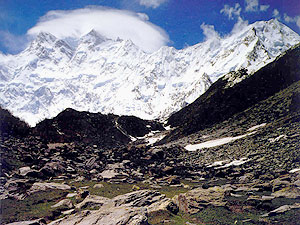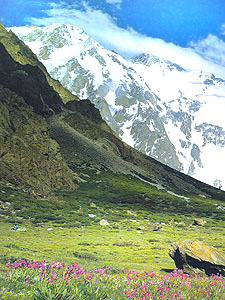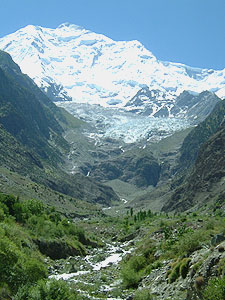Service & Area
Quick Links
Nanga Parbat
 Nanga Parbat is the most westerly buttress of the Himalaya, divided from the Hindukush by the gorge of the Indus. It is 8126m in height and when viewed from the west, is probably the most spectacular mountain on earth, for it rises near-sheer from the bed of the Indus for 7015 m of vertical height , 4 & half miles plunging, to all intents and purposes, vertically from the summit ridge, down through fields of ice and snow, down precipices and glaciers, down overhangs and rock-walls, down through scrub and scree and into a gorge which is 100 times more terrifying than the Grand Canyon – a suffocating, rock-bound desert, where nothing grows and nothing lives, and the gneiss disintegrates in an average summer temperature of over 120°F (49°C). This, as Vigne wrote 150 years ago, 'is the most awful and most magnificent sight to be met with in the Himalayas.' Nanga Parbat or "Nanga Parvata" means the naked mountain. Its original and appropriate name, however, is Diamir the king of the mountains. Nanga Parbat has always been associated with tragedies and tribulations until it was climbed in 1953. A lot of mountaineers have perished on Nanga Parbat since 1895. Even today it is claiming a heavy toll of mountaineers becoming victims in their pursuit to its summit.
Nanga Parbat is the most westerly buttress of the Himalaya, divided from the Hindukush by the gorge of the Indus. It is 8126m in height and when viewed from the west, is probably the most spectacular mountain on earth, for it rises near-sheer from the bed of the Indus for 7015 m of vertical height , 4 & half miles plunging, to all intents and purposes, vertically from the summit ridge, down through fields of ice and snow, down precipices and glaciers, down overhangs and rock-walls, down through scrub and scree and into a gorge which is 100 times more terrifying than the Grand Canyon – a suffocating, rock-bound desert, where nothing grows and nothing lives, and the gneiss disintegrates in an average summer temperature of over 120°F (49°C). This, as Vigne wrote 150 years ago, 'is the most awful and most magnificent sight to be met with in the Himalayas.' Nanga Parbat or "Nanga Parvata" means the naked mountain. Its original and appropriate name, however, is Diamir the king of the mountains. Nanga Parbat has always been associated with tragedies and tribulations until it was climbed in 1953. A lot of mountaineers have perished on Nanga Parbat since 1895. Even today it is claiming a heavy toll of mountaineers becoming victims in their pursuit to its summit.
Nanga Parbat was the first of the 8000m peaks to be attempted. In 1895, three experienced British alpinists A. F .Mummery, Hastings and Norman Collie, together with a Gurkha officer Major Bruce accompanied by two of his regiment, surveyed the southern and western slopes up to the Bazhin glacier. The slopes offered little prospects of success. Mummery, therefore, proposed to cross the high ridge running north-west from the summit During the expedition Collie & a Gurkha were taken ill and Bruce's leave expired. The attempt on the summit was therefore abandoned, and the party split up, Collie and Hastings descending via the route up which they had come, while Mummery and the Gurkhas decided to reconnoiter a col a little to the east. On 24 August the three men set out for the col and were never seen again assumed swept by an avalanche. The killer mountain had struck it first tragic blow, other and greater tragedies were to follow.
Thirty seven years later, in 1932 a German-American team under Willy Merkl made a determined assault which, although it did not succeed, managed to pioneer a possible route through the Rakhiot glacier to the summit and could go till 7100m. Merkl's team consisted of climbers who had plenty of alpine but little Himalayan experience to organize the transport and liaison with the porters. Difficulties with the porters and unfavourable weather conditions made it impossible to progress, and they retreated
 The German-Austrian expedition of 1934 was one of the largest ever to tackle major peak: nine experienced climbers, three scientists, two transport officers, 3 experienced Sherpas, and no fewer than 500 porters. By early June, four glacier camps had been established and provisioned. Everything seemed organized for an early attempt on the summit. Then came an unexpected tragedy. Alfred Drexel caught a chill, the chill turned to pneumonia, his condition rapidly deteriorated and he died of oedema of the lungs. The mountaineers and porters were then called back from climbing operations to the base camp for Drexel's funeral. Eleven cloudless days went by spent in the base camp due to the funeral and porters food not reaching the base. It therefore looks as though there must have been yet another misunderstanding between climbers and porters.
The German-Austrian expedition of 1934 was one of the largest ever to tackle major peak: nine experienced climbers, three scientists, two transport officers, 3 experienced Sherpas, and no fewer than 500 porters. By early June, four glacier camps had been established and provisioned. Everything seemed organized for an early attempt on the summit. Then came an unexpected tragedy. Alfred Drexel caught a chill, the chill turned to pneumonia, his condition rapidly deteriorated and he died of oedema of the lungs. The mountaineers and porters were then called back from climbing operations to the base camp for Drexel's funeral. Eleven cloudless days went by spent in the base camp due to the funeral and porters food not reaching the base. It therefore looks as though there must have been yet another misunderstanding between climbers and porters.
Finally the climbing resumed and the lead climbers reached the north-east summit of Nanga Parbat . On the morning of 6 July, five climbers and II Sherpas were poised for the final assault from Camp VIII, on the saddle at 7854m beneath the summit all within their grasp just 275 m away. Had the fittest of the five climbers attempted Nanga Parbat that afternoon, the first 8000m peak would almost certainly have been climbed. But Merkl wanted all five of his team members to reach the summit together; so they waited, to give the more exhausted climbers a chance to recuperate, confident that the next day would bring success for them all. Instead it brought the monsoons and bad weather set in for days. It seems the 11 clear days unnecessarily lost at base camp were to lead to one of the most terrible disasters in the history of mountaineering.
The weather remained bad for nine consecutive days with blizzards and snow storms, when it cleared, three climbers Merkl, Welzenbach, Wieland, and six sherpas had died slowly and painfully, huddled together in tents or ice-caves which became their graves. There have been alpine disasters of greater magnitude - whole expeditions snuffed out by some catastrophic avalanche - but none of such protracted horror: nine days of long, slow, agonizing death from cold, exposure and starvation.
In 1937 the Germans again laid seige to Nanga Parbat. The expedition led by Karl Wien had seven experienced climbers, , two scientists, a doctor, a cartographer, a transport officer, 12 experienced porters from Darjeeling and a number of carefully selected Baltis for work in the lower camps. Everything went fine and camp IV was set below the Rakhiot peak, when a terrible avalanche struck the camp and buried all the seven climbers and nine sherpas . The killer mountain had taken 16 lives within seconds.
The German Himalayan expedition of 1938 was led by Paul Bauer. The party did not achieve anything substantial and went home safely. However, this expedition had its moment of sorrow when at 7,000m it found several bodies from the 1934 disaster including Willy Merkls some frozen solid in snow caves, others hanging from fixed ropes on the ice-wall.
In 1939, a German expedition visited Nanga Parbat which was not really an assault but more of a reconnaissance of the Diamer rock face which had defeated Mummery. It was led by Peter Aufschnaiter. They found the rock face technically difficult and highly dangerous with vertical and unstable walls swept by avalanches. In the face of great difficulty and constant danger, they managed to just reach 6009 m before 'retreating . Their return to India coincided with the outbreak of World War II and they were interned. They managed to escape to Tibet staying at Lahsa with the Dalai Lama related in a travel classic "Seven years in Tibet"
In 1950, a party of three Englishmen, led by J.W.Thornley, made a winter attempt on the mountain through the Rakhiot face. This time the "killer" mountain claimed a toll of two lives.
In 1953 an Austro German expedition was organized by Dr. K.M. Herligkoffer step brother of Willy Merkl, it was led by Peter Aschen brenner. The expedition ran into all sorts of delays with doubts, opposition, lack of funds , late start .
They established camp V at 6,900m, on the north-east ridge between Rakhiot peak and Silver Saddle the weather was poor; it looked as though the monsoon was breaking early, and on 29 June Aschenbrenner gave the order to abandon the few camps which had been set up, and withdrew calling of the expedition.
There were, however, a handful of men unwilling to give up so easily. And four of them- Buhl, Ertl, Frauenberg and Kempter- refused to obey their leader's instructions to come down. They argued over the radio, there was still a chance. In answer to their prayers, a spell of clear weather followed.
The four men decided to 'go it alone'. They climbed swiftly to Camp V; and by the evening of 2 July, Buhl and Kempter were a little below the Silver Saddle, ready for an attack on the summit still 4000 feet (1220 m) above knowing no matter how early they started and how easy the climb, they could not get there and back in a single day realizing at around 7625 m they would have to spend a night in the open, without tents.
It was the sort of risk that most mountaineers would have thought unacceptable. Buhl set out next morning at the unlikely hour of 1.00 a.m.! Kempter tried to follow a couple of hours later but had to give up. It was now a case of one man, against all the odds, taking on Nanga Parbat alone.
 Buhl made steady progress by moonlight but the sun, when it rose, was almost unbearably hot and he suffered badly from lassitude. At midday he cached his rucksack, food and spare pullover on the subsidiary summit 7915 m. So far the ascent had presented no problems - but the final stage turned out to be not so easy - a steep rock face with its south face falling sheer 4270 m to the valleys at Buhl's feet. It was 6.00 p.m. before he came to the last gendarme: 'a massive obstruction which had to be traversed with great care. I scrambled up it on all fours- I could climb it no other way- and suddenly realized I was able to go no higher. I was on the summit!'
Buhl made steady progress by moonlight but the sun, when it rose, was almost unbearably hot and he suffered badly from lassitude. At midday he cached his rucksack, food and spare pullover on the subsidiary summit 7915 m. So far the ascent had presented no problems - but the final stage turned out to be not so easy - a steep rock face with its south face falling sheer 4270 m to the valleys at Buhl's feet. It was 6.00 p.m. before he came to the last gendarme: 'a massive obstruction which had to be traversed with great care. I scrambled up it on all fours- I could climb it no other way- and suddenly realized I was able to go no higher. I was on the summit!'
After taking the mandatory photographs, he began what he must have known was a race with death, 'for already the sun was disappearing below the horizon.
The events of the next few minutes could have been fatal. First, in a state of forgetful euphoria, he left his ice-axe on the summit. Then, halfway down a precipitous ice-slope, his right crampon slipped off his boot, 'leaving me standing like a stork on the smooth, hard ice in one crampon, supporting myself as best I could with my ski-sticks, and with no idea of how to extricate myself.' Somehow, he managed to inch his way to safety, Half an hour later it was dark.
Buhl spent the night - incredible as it sounds - standing on a wobbly block of stone in the middle of a steep rock face. There was not enough level ground for him to crouch, let alone to sit all night he had to hang on to the rock face with one hand and his ski-sticks with the other, and he had nothing - not even a pullover - to keep him warm. All this was at a height of more than 7930 m.
Itinerary . Flexible expeditions itineraries are made by us looking at your requirements and demands.
For Broad Peak 8047m, Distaghil 7885 m, Kunyang Chhish 7852m, Masherbrum 7,821 m, Rakaposhi 7,788 m, Batura 7,785 m, Kanjut Sar 7,760 m, Chogolisa 7,665 m,and other major 7600 & 6000 peaks in the Karakorum Himalayas contact our office for details.
